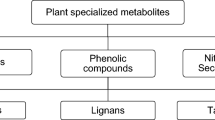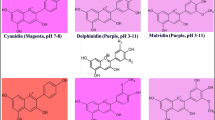Abstract
Tryptophan decarboxylase (TDC) converts tryptophan into tryptamine that is the indole moiety of ajmalicine. The full-length cDNA of Rauvolfia verticillata (RvTDC) was 1,772 bps that contained a 1,500-bp ORF encoding a 499-amino-acid polypeptide. Recombinant 55.5 kDa RvTDC converted tryptophan into tryptamine. The K m of RvTDC for tryptophan was 2.89 mM, higher than those reported in other TIAs-producing plants. It demonstrated that RvTDC had lower affinity to tryptophan than other plant TDCs. The K m of RvTDC was also much higher than that of strictosidine synthase and strictosidine glucosidase in Rauvolfia. This suggested that TDC might be the committed-step enzyme involved in ajmalicine biosynthesis in R. verticillata. The expression of RvTDC was slightly upregulated by MeJA; the five MEP pathway genes and SGD showed no positive response to MeJA; and STR was sharply downregulated by MeJA. MeJA-treated hairy roots produced higher level of ajmalicine (0.270 mg g−1 DW) than the EtOH control (0.183 mg g−1 DW). Highest RvTDC expression level was detected in hairy root, about respectively 11, 19, 65, and 109-fold higher than in bark, young leaf, old leaf, and root. Highest ajmalicine content was also found in hairy root (0.249 mg g−1 DW) followed by in bark (0.161 mg g−1 DW) and young leaf (0.130 mg g−1 DW), and least in root (0.014 mg g−1 DW). Generally, the expression level of RvTDC was positively consistent with the accumulation of ajmalicine. Therefore, it could be deduced that TDC might be the key enzyme involved in ajmalicine biosynthesis in Rauvolfia.








Similar content being viewed by others
Abbreviations
- ABA:
-
Abscisic acid
- ASA:
-
Acetyl salicylic acid
- ANOVA:
-
Analysis of Variance
- DW:
-
Dry weight
- DXR:
-
1-Deoxy-d-xyluolse 5-phosphate reductase
- HDR:
-
1-Hydroxy-2-methyl-2-(E)-butenyl 4-diphosphate reductase
- HDS:
-
1-Hydroxy-2-methyl-2-(E)-butenyl 4-diphosphate synthase
- MECPS:
-
2-C-methyl-d-erythritol 2,4-cyclodiphosphate synthase
- MCT:
-
4-(Cytidine 5′-diphospho)-2-C-methyl-d-erythritol 4-phosphate transferase
- MeJA:
-
Methyl jasmonate
- MEP:
-
2-C-methyl-d-erythritol 4-phosphate
- MVA:
-
Mevalonate
- SGD:
-
Strictosidine glucosidase
- STR:
-
Strictosidine synthase
- TDC:
-
Tryptophan decarboxylase
- TIAs:
-
Terpenoid indole alkaloids
- UV:
-
Ultraviolet light
References
Audrey O, Martine C, Marc R, Marc C (2007) The iridoid pathway in Catharanthus roseus alkaloid biosynthesis. Phytochem Rev 6:259–276
Binder BY, Peebles CA, Shanks JV, San KY (2009) The effects of UV-B stress on the production of terpenoid indole alkaloids in Catharanthus roseus hairy roots. Biotechnol Prog 25:861–865
Cai ZQ, Wang WH, Yang J, Cai CT (2009) Growth, photosynthesis and root reserpine concentrations of two Rauvolfia species in response to a light gradient. Ind Crop Prod 30:220–226
Canel C, Lopes-Cardoso MI, Whitmer S, van der Fits L, Pasquali G, van der Heijden R, Hoge JH, Verpoorte R (1998) Effects of over-expression of strictosidine synthase and tryptophan decarboxylase on alkaloid production by cell cultures of Catharanthus roseus. Planta 205:414–419
Contin A, van der Heijden R, Lefeber AW, Verpoorte R (1998) The iridoid glucoside secologanin is derived from the novel triose phosphate/pyruvate pathway in a Catharanthus roseus cell culture. FEBS Lett 434:413–416
Cordoba E, Salmi M, Leon P (2009) Unravelling the regulatory mechanisms that modulate the MEP pathway in higher plants. J Exp Bot 60:2933–2943
De Luca V, Marineau C, Brisson N (1989) Molecular cloning and analysis of cDNA encoding a plant tryptophan decarboxylase: comparison with animal dopa decarboxylases. Proc Natl Acad Sci USA 86:2582–2586
El-Sayed Magdi, Verpoorte R (2007) Catharanthus terpenoid indole alkaloids: biosynthesis and regulation. Phytochem Rev 6:277–305
Gerasimenko I, Sheludko Y, Ma X, Stockigt J (2002) Heterologous expression of a Rauvolfia cDNA encoding strictosidine glucosidase, a biosynthetic key to over 2000 monoterpenoid indole alkaloids. Eur J Biochem 269:2204–2213
Gerber E, Hemmerlin A, Hartmann M, Heintz D, Hartmann MA, Mutterer J, Rodriguez-Concepcion M, Boronat A, Van Dorsselaer A, Rohmer M, Crowell DN, Bach TJ (2009) The plastidial 2-C-methyl-d-erythritol 4-phosphate pathway provides the isoprenyl moiety for protein geranylgeranylation in tobacco BY-2 cells. Plant Cell 21:285–300
Goddijn OJ, Lohman FP, de Kam RJ, Schilperoort RA, Hoge JH (1994) Nucleotide sequence of the tryptophan decarboxylase gene of Catharanthus roseus and expression of tdc-gusA gene fusions in Nicotiana tabacum. Mol Gen Genet 242:217–225
Goddijn OJ, Pennings EJ, van der Helm P, Schilperoort RA, Verpoorte R, Hoge JH (1995) Overexpression of a tryptophan decarboxylase cDNA in Catharanthus roseus crown gall calluses results in increased tryptamine levels but not in increased terpenoid indole alkaloid production. Transgen Res 4:315–323
Gong YF, Liao ZH, Guo BH, Sun XF, Tang KX (2006) Molecular cloning and expression profile analysis of Ginkgo biloba DXS gene encoding 1-deoxy-d-xylulose 5-phosphate synthase, the first committed enzyme of the 2-C-methyl-d-erythritol 4-phosphate pathway. Planta Med 72:329–335
Hedhili S, Courdavault V, Giglioli-Guivarc’h N, Gantet P (2007) Regulation of the terpene moiety biosynthesis of Catharanthus roseus terpene indole alkaloids. Phytochem Rev 6:341–351
Hibi N, Fujita T, Hatano M, Hashimoto T, Yamada Y (1992) Putrescine methyltransferase in cultured roots of Hyoscyamus albus: n-butylamine as a potent inhibitor of the transferase both in vitro and in vivo. Plant Physiol 100:826–835
Hong SB, Hughes EH, Shanks JV, San KY, Gibson SI (2003) Role of the nonmevalonate pathway in indole alkaloid production by Catharanthus roseus hairy roots. Biotechnol Prog 19:1105–1108
Imbault N, Thiersault M, Dupéron P, Benabdelmouna A, Pierre D (1996) Pravastatin: a tool for investigating the availability of mevalonate metabolites for primary and secondary metabolism in Catharanthus roseus cell suspensions. Physiol Plant 98:803–809
Islas I, Loyola-Vargas VM, Miranda-Ham ML (1994) Tryptophan decarboxylase activity in transformed roots from Catharanthus roseus and its relationship to tryptamine, ajmalicine, and catharanthine accumulation during the culture cycle. In Vitro Cell Dev Biol Plant 30:81–83
Julsing MK, Koulman A, Woerdenbag HJ, Quax WJ, Kayser O (2006) Combinatorial biosynthesis of medicinal plant secondary metabolites. Biomol Eng 23:265–279
Kang S, Kang K, Lee K, Back K (2007) Characterization of rice tryptophan decarboxylases and their direct involvement in serotonin biosynthesis in transgenic rice. Planta 227:263–272
Lee-Parsons CW, Erturk S, Tengtrakool J (2004) Enhancement of ajmalicine production in Catharanthus roseus cell cultures with methyl jasmonate is dependent on timing and dosage of elicitation. Biotechnol Lett 26:1595–1599
Li S, Long J, Ma Z, Xu Z, Li J, Zhang Z (2004) Assessment of the therapeutic activity of a combination of almitrine and raubasine on functional rehabilitation following ischaemic stroke. Curr Med Res Opin 20:409–415
Lopez-Meyer M, Nessler CL (1997) Tryptophan decarboxylase is encoded by two autonomously regulated genes in Camptotheca acuminata which are differentially expressed during development and stress. Plant J 11:1167–1175
Ma X, Panjikar S, Koepke J, Loris E, Stockigt J (2006) The structure of Rauvolfia serpentina strictosidine synthase is a novel six-bladed beta-propeller fold in plant proteins. Plant Cell 18:907–920
Mahroug S, Burlat V, Benoit S (2007) Cellular and sub-cellular organisation of the monoterpenoid indole alkaloid pathway in Catharanthus roseus. Phytochem Rev 6:363–381
Memelink J, Verpoorte R, Kijne JW (2001) ORCAnization of jasmonate-responsive gene expression in alkaloid metabolism. Trends Plant Sci 6:212–219
Menke FL, Parchmann S, Mueller MJ, Kijne JW, Memelink J (1999) Involvement of the octadecanoid pathway and protein phosphorylation in fungal elicitor-induced expression of terpenoid indole alkaloid biosynthetic genes in Catharanthus roseus. Plant Physiol 119:1289–1296
Moyano E, Jouhikainen K, Tammela P, Palazon J, Cusido RM, Pinol MT, Teeri TH, Oksman-Caldentey KM (2003) Effect of pmt gene overexpression on tropane alkaloid production in transformed root cultures of Datura metel and Hyoscyamus muticus. J Exp Bot 54:203–211
O’Connor SE, Maresh JJ (2006) Chemistry and biology of monoterpene indole alkaloid biosynthesis. Nat Prod Rep 23:532–547
Park S, Kang K, Lee K, Choi D, Kim YS, Back K (2009) Induction of serotonin biosynthesis is uncoupled from the coordinated induction of tryptophan biosynthesis in pepper fruits (Capsicum annuum) upon pathogen infection. Planta 230:1197–1206
Panikashvili D, Savaldi-Goldstein S, Mandel T, Yifhar T, Franke RB, Hofer R, Schreiber L, Chory J, Aharoni A (2007) The Arabidopsis DESPERADO/AtWBC11 transporter is required for cutin and wax secretion. Plant Physiol 145:1345–1360
Pennings EJ, Hegger I, van der Heijden R, Duine JA, Verpoorte R (1987) Assay of tryptophan decarboxylase from Catharanthus roseus plant cell cultures by high-performance liquid chromatography. Anal Biochem 165:133–136
Ruppert M, Ma XY, Stockigt J (2005) Alkaloid biosynthesis in Rauvolfia-cDNA cloning of major enzymes of the ajmaline pathway. Curr Org Chem 9:1431–1444
Sato F, Hashimoto T, Hachiya A, Tamura K, Choi KB, Morishige T, Fujimoto H, Yamada Y (2001) Metabolic engineering of plant alkaloid biosynthesis. Proc Natl Acad Sci USA 98:367–372
Shoji T, Kajikawa M, Hashimoto T (2010) Clustered transcription factor genes regulate nicotine biosynthesis in tobacco. Plant Cell 22:3390–3409
Sudha CG, Obul Reddy B, Ravishankar GA, Seeni S (2003) Production of ajmalicine and ajmaline in hairy root cultures of Rauvolfia micrantha Hook f., a rare and endemic medicinal plant. Biotechnol Lett 25:631–636
Toney MD (2005) Reaction specificity in pyridoxal phosphate enzymes. Arch Biochem Biophys 433:279–287
Valletta A, Trainotti L, Santamaria AR, Pasqua G (2010) Cell-specific expression of tryptophan decarboxylase and 10-hydroxygeraniol oxidoreductase, key genes involved in camptothecin biosynthesis in Camptotheca acuminata Decne (Nyssaceae). BMC Plant Biol 10:69
van Der Heijden R, Jacobs DI, Snoeijer W, Hallard D, Verpoorte R (2004) The Catharanthus alkaloids: pharmacognosy and biotechnology. Curr Med Chem 11:607–628
Wei S (2010) Methyl jasmonic acid induced expression pattern of terpenoid indole alkaloid pathway genes in Catharanthus roseus seedlings. Plant Growth Regul 61:243–251
Yamazaki Y, Sudo H, Yamazaki M, Aimi N, Saito K (2003) Camptothecin biosynthetic genes in hairy roots of Ophiorrhiza pumila: cloning, characterization and differential expression in tissues and by stress compounds. Plant Cell Physiol 44:395–403
Yao K, De Luca V, Brisson N (1995) Creation of a metabolic sink for tryptophan alters the henylpropanoid pathway and the susceptibility of potato to Phytophthora infestans. Plant Cell 7:1787–1799
Zhang L, Ding R, Chai Y, Bonfill M, Moyano E, Oksman-Caldentey KM, Xu T, Pi Y, Wang Z, Zhang H, Kai G, Liao Z, Sun X, Tang K (2004) Engineering tropane biosynthetic pathway in Hyoscyamus niger hairy root cultures. Proc Natl Acad Sci USA 101:6786–6791
Zhao J, Zhu WH, YQ W, Q H (1999) Determination of indole alkaloids in Catharanthus roseus tissue and cell cultures by RP-HPLC. Acta Pharm Sin 34: 539-542
Acknowledgments
This research is financially supported by National Natural Science Foundation of China (31070266), 863 Hi-Tech Project (2011AA100605) and the key project of Chongqing Science and Technology Committee (2009AB1185).
Author information
Authors and Affiliations
Corresponding author
Rights and permissions
About this article
Cite this article
Liu, W., Chen, R., Chen, M. et al. Tryptophan decarboxylase plays an important role in ajmalicine biosynthesis in Rauvolfia verticillata . Planta 236, 239–250 (2012). https://doi.org/10.1007/s00425-012-1608-z
Received:
Accepted:
Published:
Issue Date:
DOI: https://doi.org/10.1007/s00425-012-1608-z




